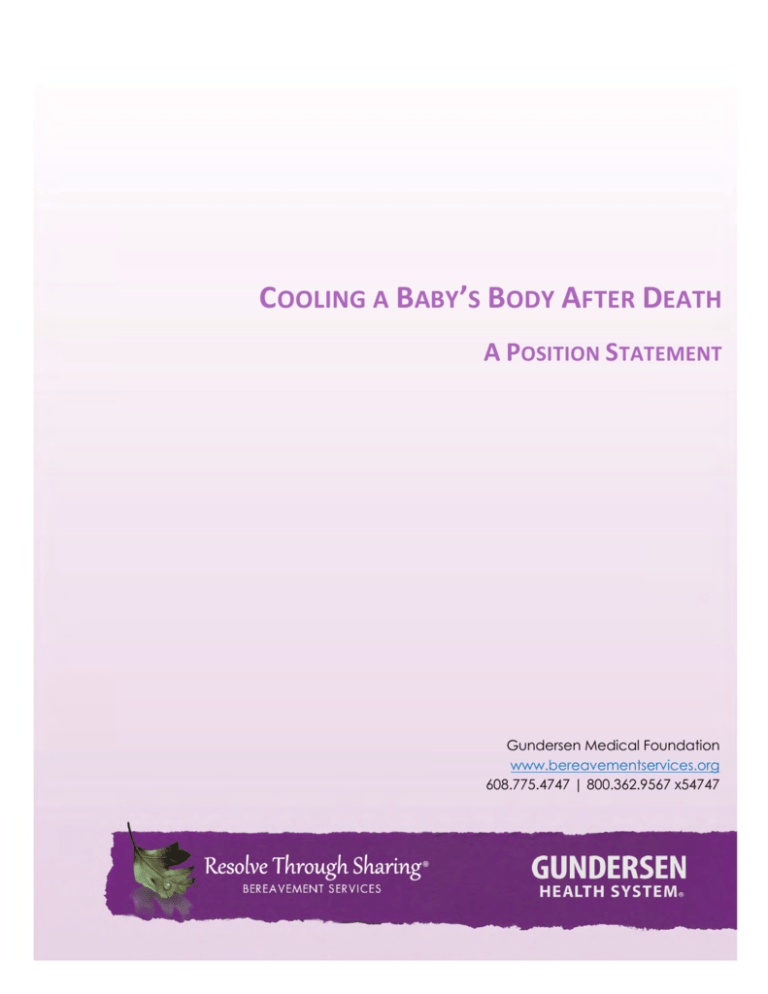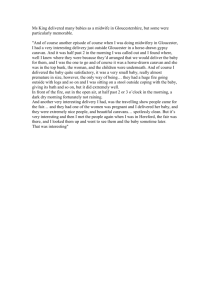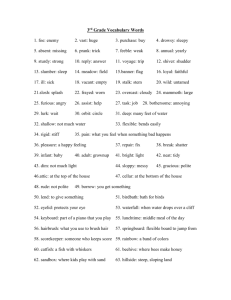
Cooling a Baby’s Body After Death
COOLING A BABY’S BODY AFTER DEATH
A POSITION STATEMENT
Gundersen Medical Foundation
www.bereavementservices.org
608.775.4747 | 800.362.9567 x54747
©Copyright 2015—All Rights Reserved. Gundersen Lutheran Medical Foundation
Cooling a Baby’s Body After Death
To cite this document
We invite you to use this position statement in references for articles, standard operating procedures,
policies, and protocols. This document may be reprinted in its entirety without alterations. Verbatim
portions of the statement or paraphrasing are permissible when the citation is included:
Wilke, J., & Limbo, R. (2015). Resolve Through Sharing® position statement on cooling a baby’s
body. La Crosse, WI: Gundersen Lutheran Medical Foundation, Inc.
2
©Copyright 2015─All Rights Reserved. Gundersen Lutheran Medical Foundation, Inc.
Cooling a Baby’s Body After Death
Position Statement
Summary
Since its inception in 1981, Resolve Through Sharing (RTS) has promoted parent and family contact with
their baby who has died. Recently, professional care providers and bereaved parents have raised the
issue of whether or not a baby’s body needs to be cooled while at the mother’s bedside. Some have
linked the length of time a baby can remain with the family and the availability of a cooling system.
Through this statement, Resolve Through Sharing experts want to reassure clinicians that they should
continue to encourage parents to spend as much time as possible with their babies without concern
about cooling provision.
Key Questions
•
Does a deceased baby need to be cooled in order to stay in the room with parents?
Rarely (See below for a few examples)
•
Does cooling determine how long the baby can be with parents and family?
No
•
If cooling is needed, what effective, low-cost options exist in a hospital?
Cooling blanket or refrigeration (small refrigerator on the unit or in the morgue)
The Facts
Generally, does a hospital need to have a cooling process for deceased babies’ bodies?
No, a deceased baby does not need to be cooled in order to stay with parents for an extended amount
of time.
After death, most parents want to continue contact with their baby through holding, bathing,
touching, kissing, and cuddling. This parent-child interaction affirms the baby’s existence and allows
for memories to be created. This time also allows for others to see and meet the baby, participate in
rituals, create keepsakes, and to say good bye.
RTS encourages families to hold their baby for as long as they desire after death has come. In most
cases, cooling the baby’s body is not essential to this process.
Under what circumstances is it recommended to use a cooling process?
Babies have stayed with parents up to several days without being cooled. However, there are things to
consider when making the decision to keep the baby in the room. Each family has to decide what is
best for them and for their baby after birth.
3
©Copyright 2015─All Rights Reserved. Gundersen Lutheran Medical Foundation, Inc.
Cooling a Baby’s Body After Death
•
Body Integrity
After death, the integrity of the baby’s body will change over time and cooling does slow the
process. In the case of a stillborn baby who has died several days or more before birth, body
integrity has already been affected because changes begin at the time of death.
Some funeral directors advise that the body’s integrity be considered for viewing purposes (e.g.,
an open casket funeral). This is a choice the parents can make based on what is more important
to them—having more time with their child in the hospital or an improved appearance later.
•
Tissue Donation
If the baby is going to be a tissue donor, the body must be cooled, and the recovery needs to
take place within a specific time frame. Your local tissue bank will assist you with this schedule.
However, the parents should have the opportunity to see and hold the baby after the surgery if
they desire to do so. At that point, cooling is no longer necessary.
•
Autopsy
If the baby is going to undergo an autopsy, the hospital laboratory protocol may require it to be
done within a specific time frame after death. However, delay has little to no impact on the
pathology studies, so the family should be given the option to see and hold their baby’s body as
long as possible before and after the procedure.
How can the baby’s body be cooled effectively?
If the family decides that they want their baby to be cooled, there are a few options: The baby can be
placed in the morgue or in a refrigerated area on the unit while the family is resting, or the baby’s
body can be handled using a cooling blanket or pad.
Surface cooling can be accomplished with cold water circulation blankets and cold forced-air blankets.
This technology is readily available in most hospitals. Neonatal blanket sizes are available if you wish
to order them. The baby can be bundled in a receiving blanket with a cooling blanket or placed on top
of the cooling blanket in a bassinet. The family can also remove the baby from the cooling blanket as
desired and then readjust when they feel cooling is needed.
Valley Children’s Hospital in Madera, California has published a photo example of a baby lying on a
cooling blanket. As noted above, a deceased baby can be set on top of or bundled with a cooling blanket
or pad.
http://www.childrenscentralcal.org/PressRoom/HospitalNews/PublishingImages/Cooling5.jpg
4
©Copyright 2015─All Rights Reserved. Gundersen Lutheran Medical Foundation, Inc.
Cooling a Baby’s Body After Death
References
For more information on industry position statements, seeing and holding babies, the care of baby after
stillbirth, infection risks, and postmortem pathology studies related to length of time the baby is held;
please use the following resources.
Resolve Through Sharing (RTS)
http://www.gundersenhealth.org/resolve-through-sharing/publications-and-research/position-papers
•
Resolve Through Sharing (RTS) Perinatal Palliative Care
Wilke, J., & Limbo, R. (Eds.). (2012). Resolve Through Sharing® bereavement training: Perinatal death
(8th ed.). La Crosse, Wisconsin: Gundersen Lutheran Medical Foundation, Inc.
Pregnancy Loss and Infant Death Alliance (PLIDA)
http://www.plida.org/position-statements
•
•
•
•
Infection risks are insignificant for bereaved parents who have close contact with their deceased
baby’s body.
When bereaved parents hold their baby’s body for any length of time after death, there is little or
no impact on postmortem pathology studies.
Bereaved parents have the right to decide whether, when, and how to spend time holding their
baby.
When offering the baby to bereaved parents, the health care provider should engage them in
ongoing conversations about their feelings and ideas and respond to their unique needs.
Other
Limbo, R., & Lathrop, A. (2014). Caregiving in mothers’ narratives of perinatal hospice. Illness, Crisis, &
Loss, 22(1), 43-65.
National Association of Neonatal Nurses. (2010). Palliative care for newborns and Infants: Position
statement #3051.
(http://www.gundersenhealth.org/upload/docs/Bereavement/Nann%20Palliative_Care-final2in_new_template_01-07-11%5b1%5d.pdf)
Warland, J., & Davis, D. (2011). Caring for families experiencing stillbirth: A unified position statement
on contact with the baby: An international collaboration.
(http://www.gundersenhealth.org/upload/docs/Bereavement/english%20seeing%20and%20holdi
ng1.pdf )
5
©Copyright 2015─All Rights Reserved. Gundersen Lutheran Medical Foundation, Inc.
@Copyright 2015—All Rights Reserved.
Gundersen Lutheran Medical Foundation, Inc.
The leaf and teardrop and Resolve Through Sharing
are registered trademarks of Gundersen Lutheran Medical Foundation, Inc.









